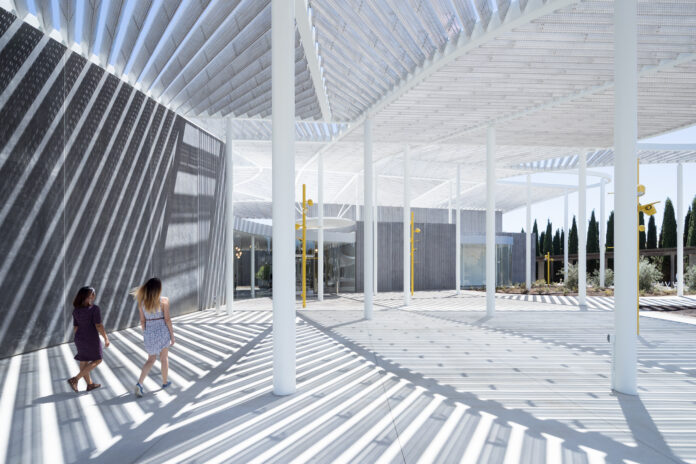The space integrates values of the Davis community at the core of its mission
By CLARA FISCHER — arts@theaggie.org
UC Davis’ very own Jan Shrem and Maria Manetti Shrem Museum of Art was recently named one of the 25 best museum buildings of the past 100 years by ARTnews. The distinction becomes especially poignant considering that only four museum spaces located in the U.S. made the list.
“The Manetti Shrem Museum was really born out of a dream of lots of people who thought it was important to have contemporary art on the university’s campus,” said Randy Roberts, deputy director of the Shrem. “There was a spirit of experimentation and innovation in art that’s very much aligned with a lot of the work that continues to come out of UC Davis.”
The space, created by architectural design firms SO-IL and Bohlin Cywinski Jackson, as well as contractor Whiting-Turner, was designed with the values of the university and its surroundings in mind. The design was inspired by and was meant to emulate the Davis landscape, with “elements of interior and exterior fluidity [that were chosen] because of where we are,” as described by Roberts.
The mission of the Shrem is multifaceted and designed with visitors in mind every step of the way.
“It’s really about centering art experiences in the ways that people are finding their place in the world,” Roberts said. “The notion being that art is about ideas, and that artists are asking questions that are of importance to all of us.”
Roberts cited the Grand Canopy as an example of these integral aspects of the museum’s design. As the main spectacle of the Shrem, not only is the massive 50,000-square-foot aluminum structure visually stunning, but it also “creates shade in a place that’s very hot. It’s very much about being here, serving students, but it also is of a building that ranks among the top in the world for seeing art.”
This duality is exactly what makes the museum so special. Both intended as a place to view art and as a place for the community to come and unleash its creative side, the Shrem was created with purpose in mind from its conception.
“One of the important things about the Manetti Shrem is that we are here to serve all disciplines,” Roberts said. “Like the library or the Mondavi Center for the Performing Arts, the idea that we bring forward is that art is central to all of our lives and can be a way that we are all exposed to new ideas and new questions and learn how to look in different ways.”
This all-encompassing approach to education and art appreciation is what sets the space apart from traditional informal educational settings — perhaps this is what made the Davis institution stand out from its more world-renowned peers.
“It isn’t the biggest museum; it doesn’t have the largest collection, but what this museum does is put education at the center of what we’re doing,” Roberts said. “There’s a third of the museum space dedicated to education, and the exhibitions themselves are positioned as a way for people to interact with art as a way to open their lives.”
Given that UC Davis prides itself on being a well-established research institution, it logically follows that the Shrem would build on this hands-on method of learning.
“Art makes sense when somebody is connecting and interacting with it,” Roberts said. “Everything is built around the idea of people in the space, which is different than a lot of art museums.”
For example, the Community Education Room has a glass door that opens up and recedes into the ceiling, allowing for the room to be transformed from a traditional classroom setting into a larger space where communities can come together.
Through collaboration with the Design Construction Management Unit at UC Davis, the Shrem was conceptualized with sustainability in mind. The building is LEEDv3 NC-Platinum certified and has achieved both a 57% reduction in irrigation water use and a 44% reduction in general water use through efficient fixtures. It also hosts a cutting-edge light system that is both environmentally friendly and in service of the best art-viewing experience.
“We have a very advanced LED lighting system where we can adjust the brightness from one piece of art to the next — we can show all different kinds of work,” Roberts said. “Who knows what the next form of media will be? [The architects] wanted to tie in as much flexibility as possible so that we could show whatever comes next.”
Above all, the Shrem is a place meant to be available for everyone. Describing museums as “holders of shared culture,” Roberts emphasized what is truly special about the unique space on campus.
“We really want people to leave feeling like museums are for them,” Roberts said. “It’s important that people see that the museum is for all of us — regardless of whether you’re an artist or not an artist or an art historian.”
Admission to the Shrem is free for all — as per the museum’s mission — which is made possible by the university and a variety of donors.
While traveling to far-off places with a rich offering of museums and galleries alike is no doubt worthy of its own merit, it is certainly exciting that one of the most well-lauded sites of the past century is so near to home. The Shrem has a multitude of exciting offerings hosted by the museum for students and non-students alike to take advantage of, all from the comfort of this very own little town.
Written by: Clara Fischer — arts@theaggie.org




